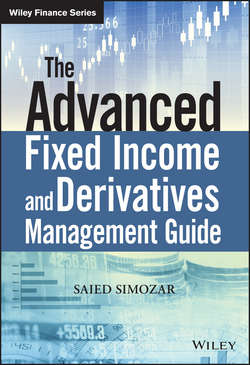Читать книгу The Advanced Fixed Income and Derivatives Management Guide - Saied Simozar - Страница 13
На сайте Литреса книга снята с продажи.
Chapter 1
Review of Market Analytics
1.2 SIMPLE BOND ANALYTICS
ОглавлениеA problem that bond managers are faced with on a regular basis is the impact of changes in interest rates on the price of a bond. For a small change in interest rates, we can expand the pricing function using Taylor series as follows:
1.6
After some simplification, the first term in the expansion is
1.7
The expression within the summation is the weighted average time to future cash flows multiplied by the price and is called the Macaulay duration. The negative sign implies that the price of bonds falls if interest rates rise. The modified duration of a bond is defined as
1.8
where D is the Macaulay duration of the bond. Modified duration measures the price sensitivity of a bond to changes in interest rates. For example, if the modified duration of a bond that is priced at 104 is 11 years, for a change of 10 bps in interest rates (10/10, 000 = 0.001 = 0.1 %), the change in the price of the bond is expected to be 0.001 × 11 × 104 = 1.144.
The second order term in (1.6) can be simplified to
1.9
This expression, denoting convexity multiplied by price, is always positive for bonds with fixed coupon payments. Market yield, modified duration, and convexity of bonds depend on coupon frequency and therefore cannot be used to compare bonds with different coupon frequencies. For example, the duration of a corporate bond that pays quarterly coupons cannot be combined with the duration of a treasury bond that pays semi-annually in a portfolio. We need to do all the calculations using the same accrual convention. Our solution is to use a continuously compounded framework.
Consider a bond with principal continuously growing at a rate of y per year. The change in the principal after a short time dt is
1.10
Integrating the above equation leads to
1.11
where p is the future value of an initial investment of p0. Likewise, the present value of a future cash flow p will be
1.12
The present value of a number of cash flows discounted by the same yield will be
1.13
Comparing (1.13) with (1.5), we find that they are identical if we make the following substitutions:
1.14
We can derive the continuously compounded yield and durations in the limit as :
1.15
In the continuously compounded framework, duration (D) and convexity (X) become much simpler to handle, and modified duration and Macaulay duration converge to the same value:
1.16
1.17
The change in the price of a security due to a small change in its yield in the continuously compounded framework is
1.18
